Processing Wax In a Crock Pot
After a season of scraping burr comb from various places in the hive, wax cappings from extracting honey and old comb from rotating out old frames it's time to do something with the bags of raw wax that are collecting in the freezer.
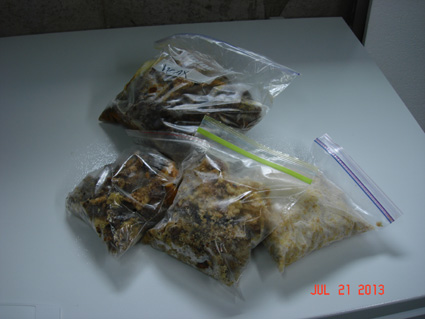
A solar wax melter is a great way to render wax during the hot summer days. Without one, or if you wish to process wax during the winter months, you can still render wax quite easily using a crock pot.
A word of caution here: use a crock pot dedicated entirely to art projects...you probably won't want to use the crock pot for meals after melting wax in it a few times.
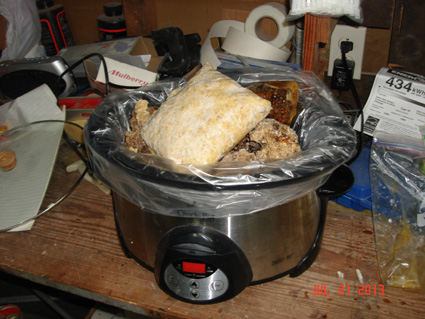
Here's a big tip: use crock pot liners. You can get a whole box of them for a buck or two. Liners really help in keeping the crock pot clean and also make pouring the wax easier. Use two bags, just in case one develops a leak (ask me how I know).
It only takes a few hours for the wax to melt entirely into a liquid state, much sooner if your wax was not frozen. There's no need for the wax to boil, just completely melt all into liquid.
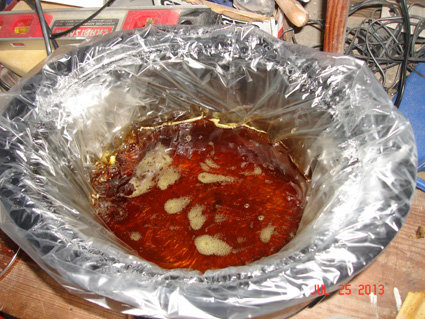
Processing wax usually takes melting and remelting several times to filter out all the honey and other impurities in the wax.
The first couple of times I melt wax, I pour it into a container filled with water. This way, the honey that is in the wax will sink to the bottom of the water and the wax will float to the top. This helps separate any honey from the wax.
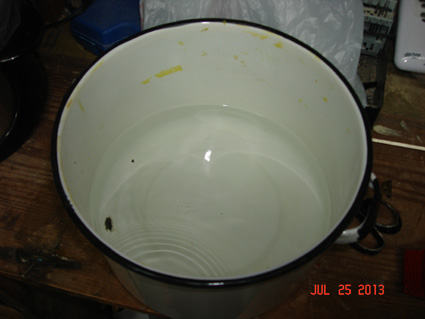
I stretch paper towels or cheese cloth across the top of the container and tape it in place. The wax and impurities will stick to the filter and will weigh it down and taping it to the sides prevents it from falling down into the container.
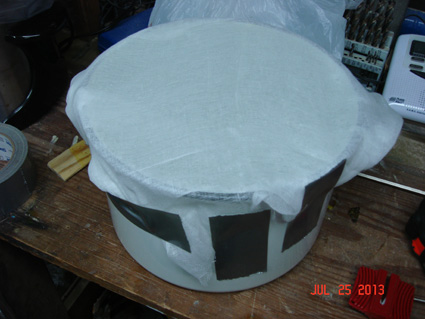
I discovered in order to use paper towels, the wax does have to be pretty hot. My theory is that paper towels made now days are good at absorbing everyday liquids including molten wax. The wax needs to be hot enough so that it pours through the paper towel (if you use paper towels) and not cool and harden while the paper towel tries to soak up the liquid wax.
In this picture below, I had an accidental hole develop in the crock pot liners which provided a steady stream of molten wax to pour through the filter. You can also manipulate the crock pot liner bag so that the wax pours out of the top of the bag.
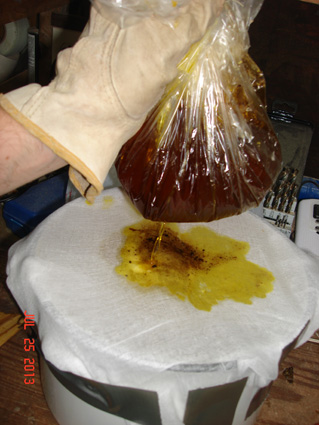
You can see how much dirt and debris the filter removed during the first filter pass. If you're using cheese cloth, I recommend folding it over and doubling up the thickness.
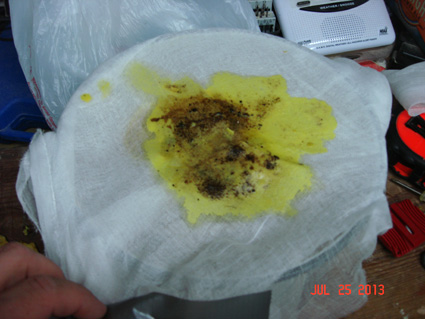
When the wax cake is completely cool, this part could take up to an hour depending on how thick the wax is, remove it from the bucket of water.
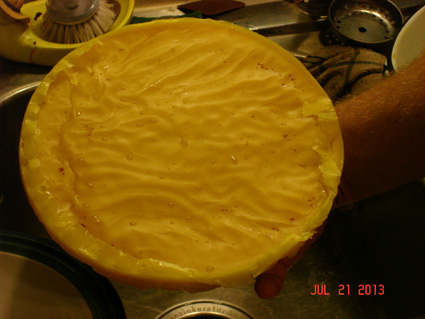
Below is a picture of what the bottom of the cooled block of wax looks like. It has a lot of little stalagmite looking structures on it as a result of the wax dripping into the water.
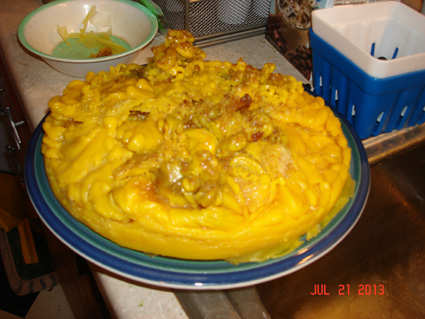
You can see how some of the tips of the stalagmite looking structures on the under-side of the cake are still brown. Those contain honey/water/dirt that did not separate or filter completely during the first filtering attempt so the wax needs to be melted down and re-filtered again.
The number of times required to melt and re-filter depends on how clean/contaminated your wax is when you start the process.
On average I end up melting and re-filtering my wax approximately three times.
Once it looks really clean with no impurities I melt it a final time and pour into a dry container with no water.

This is a picture of a block of wax that I've filtered twice into water and a final time into a dry container. The top and bottom of the wax show no impurities and I'm pretty happy with it.
This block of wax can be saved or made into products such as lip balm, candles, lotions, soaps, etc.
Additional Notes:
1. There is a possibility that honey, water and other impurities in your wax could grow into mold and ruin your wax pretty quick if it's not frozen in between filtering. Once you're satisfied it's all clean and filtered, you can store or display your wax at room temperature.
2. According to WikiPedia, Beeswax has a relatively low melting point range of 62 to 64 °C (144 to 147 °F). If beeswax is heated above 85 °C (185 °F) discoloration occurs. The flash point of beeswax is 204.4 °C (399.9 °F). I don't recommend leaving the house while the wax is melting in the crock pot, you know, just in case.
3. There's no need to defrost frozen wax collected during the season, just toss frozen blocks of burr comb directly into the crock pot.
If you've got any comments or suggestions, please include them in the comments section below. I'd love to have them included!

A solar wax melter is a great way to render wax during the hot summer days. Without one, or if you wish to process wax during the winter months, you can still render wax quite easily using a crock pot.
A word of caution here: use a crock pot dedicated entirely to art projects...you probably won't want to use the crock pot for meals after melting wax in it a few times.

Here's a big tip: use crock pot liners. You can get a whole box of them for a buck or two. Liners really help in keeping the crock pot clean and also make pouring the wax easier. Use two bags, just in case one develops a leak (ask me how I know).
It only takes a few hours for the wax to melt entirely into a liquid state, much sooner if your wax was not frozen. There's no need for the wax to boil, just completely melt all into liquid.

Processing wax usually takes melting and remelting several times to filter out all the honey and other impurities in the wax.
The first couple of times I melt wax, I pour it into a container filled with water. This way, the honey that is in the wax will sink to the bottom of the water and the wax will float to the top. This helps separate any honey from the wax.

I stretch paper towels or cheese cloth across the top of the container and tape it in place. The wax and impurities will stick to the filter and will weigh it down and taping it to the sides prevents it from falling down into the container.

I discovered in order to use paper towels, the wax does have to be pretty hot. My theory is that paper towels made now days are good at absorbing everyday liquids including molten wax. The wax needs to be hot enough so that it pours through the paper towel (if you use paper towels) and not cool and harden while the paper towel tries to soak up the liquid wax.
In this picture below, I had an accidental hole develop in the crock pot liners which provided a steady stream of molten wax to pour through the filter. You can also manipulate the crock pot liner bag so that the wax pours out of the top of the bag.

You can see how much dirt and debris the filter removed during the first filter pass. If you're using cheese cloth, I recommend folding it over and doubling up the thickness.

When the wax cake is completely cool, this part could take up to an hour depending on how thick the wax is, remove it from the bucket of water.

Below is a picture of what the bottom of the cooled block of wax looks like. It has a lot of little stalagmite looking structures on it as a result of the wax dripping into the water.

You can see how some of the tips of the stalagmite looking structures on the under-side of the cake are still brown. Those contain honey/water/dirt that did not separate or filter completely during the first filtering attempt so the wax needs to be melted down and re-filtered again.
The number of times required to melt and re-filter depends on how clean/contaminated your wax is when you start the process.
On average I end up melting and re-filtering my wax approximately three times.
Once it looks really clean with no impurities I melt it a final time and pour into a dry container with no water.

This is a picture of a block of wax that I've filtered twice into water and a final time into a dry container. The top and bottom of the wax show no impurities and I'm pretty happy with it.
This block of wax can be saved or made into products such as lip balm, candles, lotions, soaps, etc.
Additional Notes:
1. There is a possibility that honey, water and other impurities in your wax could grow into mold and ruin your wax pretty quick if it's not frozen in between filtering. Once you're satisfied it's all clean and filtered, you can store or display your wax at room temperature.
2. According to WikiPedia, Beeswax has a relatively low melting point range of 62 to 64 °C (144 to 147 °F). If beeswax is heated above 85 °C (185 °F) discoloration occurs. The flash point of beeswax is 204.4 °C (399.9 °F). I don't recommend leaving the house while the wax is melting in the crock pot, you know, just in case.
3. There's no need to defrost frozen wax collected during the season, just toss frozen blocks of burr comb directly into the crock pot.
If you've got any comments or suggestions, please include them in the comments section below. I'd love to have them included!
Comments For This Post: (5) | Post Your Comments! Hide The Comment Form